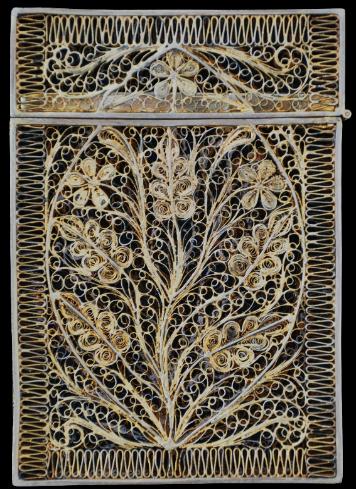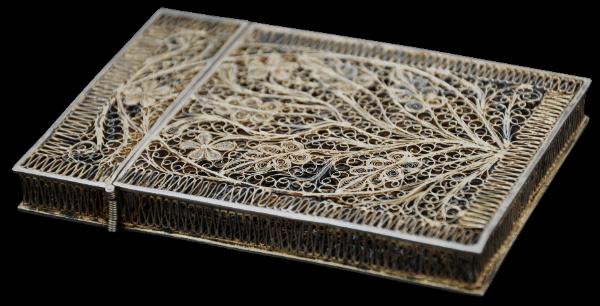
Gilded Silver Filigree Indian Calling Card Case
Gilded Filigree Card Case
Orissa, India
circa 1820
height: 10cm, width: 7cm, thickness: 1cm, weight:52g
This very fine gold-plated silver filigree visiting card case is typical of the filigree work of Cuttack, Orissa and most probably dates to the 1820s. The main floral design repeated front and back is reminiscent of pinks or carnations portrayed on Ottoman ceramics which was copied in Mughal metalwork. The lid is attached to the case via a hinge to one side. There are no maker’s marks.
Calling cards were very important to the social rituals of colonial life in India. One was required to participate in ‘the call’ when one arrived in a new settlement either on a posting or even if just visiting. New arrivals would have elaborate calling cards printed and would then make the ‘call’, dressed formally, on each residence of relevance or importance in the new place of posting. It was a prelude to social acceptance and invitations to subsequent dinner parties and similar events. Just as it was mandatory to make ‘the call’ on one’s arrival to a new posting, it was equally as mandatory for those called upon not to receive the would-be guest and to be pronounced as ‘not at home’ even if they were. The visitor simply presented a servant with their calling card which was placed on a silver tray and then they left, making their way to the next residence to repeat the procedure. According to Dehejia (2008) married couples made the call together, bachelors on their own, and unmarried women did so in the company of their local hostess.
Calling cards were printed on expensive, thick paper. They were kept in especially-made carrying cases, usually of silver, to prevent them from becoming soiled. Different types of cases were made across many parts of India. Men tended to carry smaller, thinner cases. Women tended to carry cases that were larger and more elaborate. The case here would have been made for a lady.
A card case with similar filigree work and attributed to 1820s Orissa is illustrated in Dehejia (2008, p. 81).
References
Dehejia, V., Delight in Design: Indian Silver for the Raj, Mapin, 2008.
Provenance
UK art market
Inventory no.: 1267
SOLD
here



